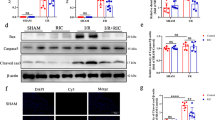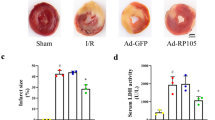Abstract
This study aimed to investigate the protective effects and mechanisms of hyperbaric oxygen (HBO) preconditioning in a rat model of acute myocardial infarction (MI) established by ligation of the left anterior descending (LAD) coronary artery. Microarray, real-time PCR, and western blotting (WB) results demonstrated that the Mst1 gene was downregulated in the heart tissue of the MI rat model. HBO preconditioning significantly increased Mst1 expression in cardiac tissues of rats after MI modeling. Lentiviral infection was used to silence the Mst1 gene in rats treated with HBO to probe the effect of Mst1 on HBO cardioprotection. HBO preconditioning decreased heart infarct size and ameliorated cardiac function in MI rats, whereas Mst1 silencing reversed the effect of HBO administration, as indicated after heat infarct size determination via TTC staining, histological examination via HE staining, and measurements of cardiac function. HBO preconditioning reduced oxidative stress and inflammation in cardiac tissue of MI rat model, evidenced by alteration of malondialdehyde (MDA), 8-hydroxy-2-deoxyguanosine (8-OHdG), and protein carbonyl contents, as well as production of inflammation-associated myeloperoxidase (MPO), IL-1β, and TNF-α. These findings provide a new signaling mechanism through which HBO preconditioning can protect against acute MI injury through the Mst1-mediating Keap1/Nrf2/HO-1-dependent antioxidant defense system.







Similar content being viewed by others
Data Availability
The data that support the findings of this study are available from the corresponding author [Di Li], upon reasonable request.
References
Wu, X., Reboll, M. R., Korf-Klingebiel, M., & Wollert, K. C. (2021). Angiogenesis after acute myocardial infarction. Cardiovascular Research, 117, 1257–1273.
Tuk, B., Tong, M., Fijneman, E. M., & van Neck, J. W. (2014). Hyperbaric oxygen therapy to treat diabetes impaired wound healing in rats. PLoS ONE, 9, e108533.
Kimmel, H. M., Grant, A., & Ditata, J. (2016). The presence of oxygen in wound healing. Wounds, 28, 264–270.
Yümün, G., Kahraman, C., Kahraman, N., Yalçınkaya, U., Akçılar, A., Akgül, E., & Vural, A. H. (2016). Effects of hyperbaric oxygen therapy combined with platelet-rich plasma on diabetic wounds: An experimental rat model. Archives of Medical Science, 12, 1370–1376.
Sun, Q., Sun, Q., Liu, Y., Sun, X., & Tao, H. (2011). Anti-apoptotic effect of hyperbaric oxygen preconditioning on a rat model of myocardial infarction. Journal of Surgical Research, 171, 41–46.
Dotsenko, E., Nikulina, N., Salivonchik, D., Lappo, O., Gritsuk, A., & Bastron, A. (2015). Low doses of hyperbaric oxygenation effectively decrease the size of necrotic zone in rats with experimental myocardial infarction. Bulletin of Experimental Biology and Medicine, 158, 732–734.
Bennett, M. H., Lehm, J. P., & Jepson, N. (2015). Hyperbaric oxygen therapy for acute coronary syndrome. Cochrane Database of Systematic Reviews, 2015(7), 4818.
Chen, C., Huang, L., Nong, Z., Li, Y., Chen, W., Huang, J., Pan, X., Wu, G., & Lin, Y. (2017). Hyperbaric oxygen prevents cognitive impairments in mice induced by d-galactose by improving cholinergic and anti-apoptotic functions. Neurochemical Research, 42, 1240–1253.
Chen, X., Li, Y., Chen, W., Nong, Z., Huang, J., & Chen, C. (2016). Protective effect of hyperbaric oxygen on cognitive impairment induced by d-galactose in mice. Neurochemical Research, 41, 3032–3041.
Yang, J., Chen, W., Zhou, X., Li, Y., Nong, Z., Zhou, L., Wei, X., Pan, X., Chen, C., & Lu, W. (2022). Hyperbaric oxygen protects against PC12 and H9C2 cell damage caused by oxygen–glucose deprivation/reperfusion via the inhibition of cell apoptosis and autophagy. Biocell, 46, 137.
Yu, W., Xu, M., Zhang, T., Zhang, Q., & Zou, C. (2019). Mst1 promotes cardiac ischemia–reperfusion injury by inhibiting the ERK-CREB pathway and repressing FUNDC1-mediated mitophagy. The Journal of Physiological Sciences, 69, 113–127.
McClatchey, A. I., & Giovannini, M. (2005). Membrane organization and tumorigenesis—The NF2 tumor suppressor, Merlin. Genes and Development, 19, 2265–2277.
Rothzerg, E., Ingley, E., Mullin, B., Xue, W., Wood, D., & Xu, J. (2021). The Hippo in the room: Targeting the Hippo signalling pathway for osteosarcoma therapies. Journal of Cellular Physiology, 236, 1606–1615.
Hui, Q., Karlstetter, M., Xu, Z., Yang, J., Zhou, L., Eilken, H. M., Terjung, C., Cho, H., Gong, J., & Lai, M. J. (2020). Inhibition of the Keap1-Nrf2 protein–protein interaction protects retinal cells and ameliorates retinal ischemia–reperfusion injury. Free Radical Biology and Medicine, 146, 181–188.
Xu, B., Zhang, J., Strom, J., Lee, S., & Chen, Q. M. (2014). Myocardial ischemic reperfusion induces de novo Nrf2 protein translation. Biochimica et Biophysica Acta (BBA) Molecular Basis of Disease, 1842, 1638–1647.
Shyu, K.-G., Lu, M.-J., Chang, H., Sun, H.-Y., Wang, B.-W., & Kuan, P. (2005). Carvedilol modulates the expression of hypoxia-inducible factor-1α and vascular endothelial growth factor in a rat model of volume-overload heart failure. Journal of Cardiac Failure, 11, 152–159.
Bouachour, G., Cronier, P., Gouello, J. P., Toulemonde, J. L., Talha, A., & Alquier, P. (1996). Hyperbaric oxygen therapy in the management of crush injuries: A randomized double-blind placebo-controlled clinical trial. Journal of Trauma, 41, 333–339.
Gao, S., Li, G., Shao, Y., Wei, Z., Huang, S., Qi, F., Jiao, Y., Li, Y., Zhang, C., & Du, J. (2021). FABP5 deficiency impairs mitochondrial function and aggravates pathological cardiac remodeling and dysfunction. Cardiovascular Toxicology, 21, 619–629.
Livak, K. J., & Schmittgen, T. D. (2001). Analysis of relative gene expression data using real-time quantitative PCR and the 2(−Delta Delta C(T)) method. Methods, 25, 402–408.
Neri, M., Fineschi, V., Di Paolo, M., Pomara, C., Riezzo, I., Turillazzi, E., & Cerretani, D. (2015). Cardiac oxidative stress and inflammatory cytokines response after myocardial infarction. Current Vascular Pharmacology, 13, 26–36.
Baird, L., & Yamamoto, M. (2020). The molecular mechanisms regulating the KEAP1-NRF2 pathway. Mol Cell Biol, 40(13), e00099-20.
Radice, S., Rossoni, G., Oriani, G., Michael, M., Chiesara, E., & Berti, F. (1997). Hyperbaric oxygen worsens myocardial low flow ischemia–reperfusion injury in isolated rat heart. European Journal of Pharmacology, 320, 43–49.
Maffei Facino, R., Carini, M., Aldini, G., Berti, F., & Rossoni, G. (1999). Panax ginseng administration in the rat prevents myocardial ischemia–reperfusion damage induced by hyperbaric oxygen: Evidence for an antioxidant intervention. Planta Medica, 65, 614–619.
Han, C., Lin, L., Zhang, W., Zhang, L., Lv, S., Sun, Q., Tao, H., Zhang, J. H., & Sun, X. (2008). Hyperbaric oxygen preconditioning alleviates myocardial ischemic injury in rats. Experimental Biology and Medicine (Maywood, N.J.), 233, 1448–1453.
Cabigas, B. P., Su, J., Hutchins, W., Shi, Y., Schaefer, R. B., Recinos, R. F., Nilakantan, V., Kindwall, E., Niezgoda, J. A., & Baker, J. E. (2006). Hyperoxic and hyperbaric-induced cardioprotection: Role of nitric oxide synthase 3. Cardiovascular Research, 72, 143–151.
Jeysen, Z. Y., Gerard, L., Levant, G., Cowen, M., Cale, A., & Griffin, S. (2011). Research report: The effects of hyperbaric oxygen preconditioning on myocardial biomarkers of cardioprotection in patients having coronary artery bypass graft surgery. Undersea and Hyperbaric Medicine, 38, 175–185.
Yin, X., Wang, X., Fan, Z., Peng, C., Ren, Z., Huang, L., Liu, Z., & Zhao, K. (2015). Hyperbaric oxygen preconditioning attenuates myocardium ischemia–reperfusion injury through upregulation of heme oxygenase 1 expression: PI3K/Akt/Nrf2 pathway involved. Journal of Cardiovascular Pharmacology and Therapeutics, 20, 428–438.
Latunde-Dada, G. O. (2017). Ferroptosis: Role of lipid peroxidation, iron and ferritinophagy. Biochimica et Biophysica Acta General Subjects, 1861, 1893–1900.
Souza-Neto, F. V., Islas, F., Jiménez-González, S., Luaces, M., Ramchandani, B., Romero-Miranda, A., Delgado-Valero, B., Roldan-Molina, E., Saiz-Pardo, M., Cerón-Nieto, M., Ortega-Medina, L., Martínez-Martínez, E., & Cachofeiro, V. (2022). Mitochondrial oxidative stress promotes cardiac remodeling in myocardial infarction through the activation of endoplasmic reticulum stress. Antioxidants (Basel), 11, 1232.
Brazão, V., Colato, R. P., Santello, F. H., Vale, GTd., Gonzaga, Nd. A., Tirapelli, C. R., & Prado Jr, JCd. (2018). Effects of melatonin on thymic and oxidative stress dysfunctions during Trypanosoma cruzi infection. Journal of Pineal Research, 65, e12510.
Ding, M., Ning, J., Feng, N., Li, Z., Liu, Z., Wang, Y., Wang, Y., Li, X., Huo, C., & Jia, X. (2018). Dynamin-related protein 1-mediated mitochondrial fission contributes to post-traumatic cardiac dysfunction in rats and the protective effect of melatonin. Journal of Pineal Research, 64, e12447.
Yao, H., He, Q., Huang, C., Wei, S., Gong, Y., Li, X., Liu, W., Xu, Z., Wu, H., & Zheng, C. (2022). Panaxatriol saponin ameliorates myocardial infarction-induced cardiac fibrosis by targeting Keap1/Nrf2 to regulate oxidative stress and inhibit cardiac-fibroblast activation and proliferation. Free Radical Biology and Medicine, 190, 264–275.
Funding
This research did not receive any specific grant from funding agencies in the public, commercial, or not-for-profit sectors.
Author information
Authors and Affiliations
Contributions
JL and YL designed the research plan. JL, YL, SW, ZZ, and DL performed the experiments and analyzed the data. DL wrote the manuscript.
Corresponding author
Ethics declarations
Conflict of interest
The authors declare that they have no conflict of interest.
Ethics Approval
All procedures were approved by the Animal Care and Use Committee of Affiliated Hospital of Hebei Engineering University.
Consent to Participate
Not applicable.
Consent to Publish
Not applicable.
Additional information
Publisher's Note
Springer Nature remains neutral with regard to jurisdictional claims in published maps and institutional affiliations.
Rights and permissions
Springer Nature or its licensor (e.g. a society or other partner) holds exclusive rights to this article under a publishing agreement with the author(s) or other rightsholder(s); author self-archiving of the accepted manuscript version of this article is solely governed by the terms of such publishing agreement and applicable law.
About this article
Cite this article
Liu, J., Li, Y., Wu, S. et al. Hyperbaric Oxygen Upregulates Mst1 to Activate Keap1/Nrf2/HO-1 Pathway Resisting Oxidative Stress in a Rat Model of Acute Myocardial Infarction. Mol Biotechnol (2024). https://doi.org/10.1007/s12033-024-01050-8
Received:
Accepted:
Published:
DOI: https://doi.org/10.1007/s12033-024-01050-8




